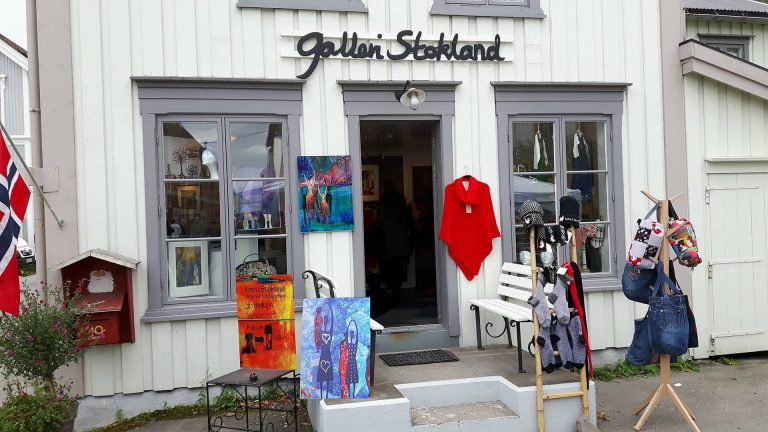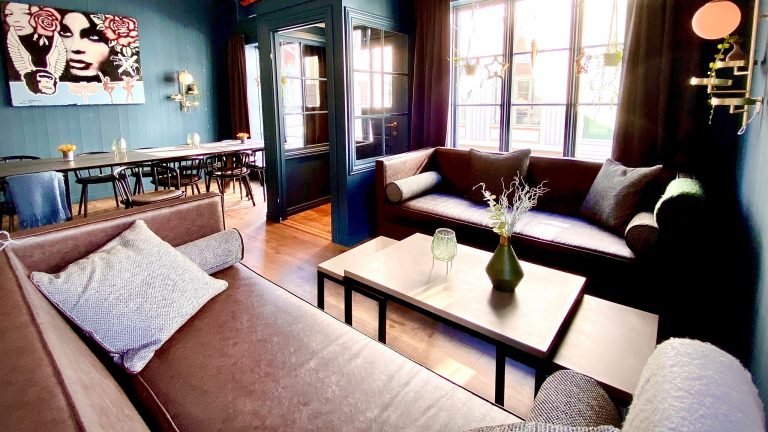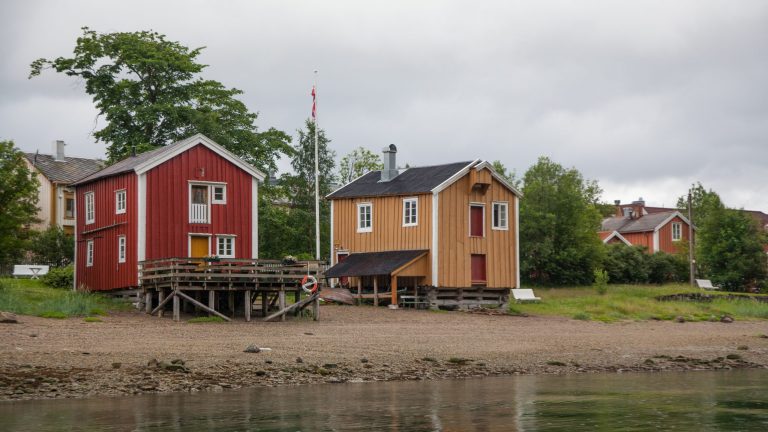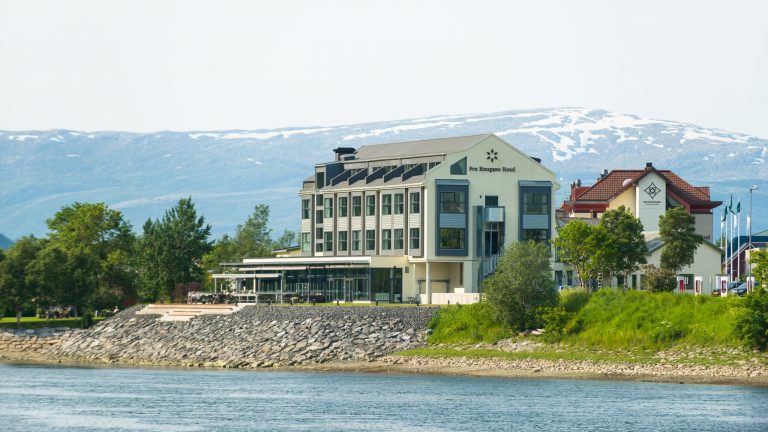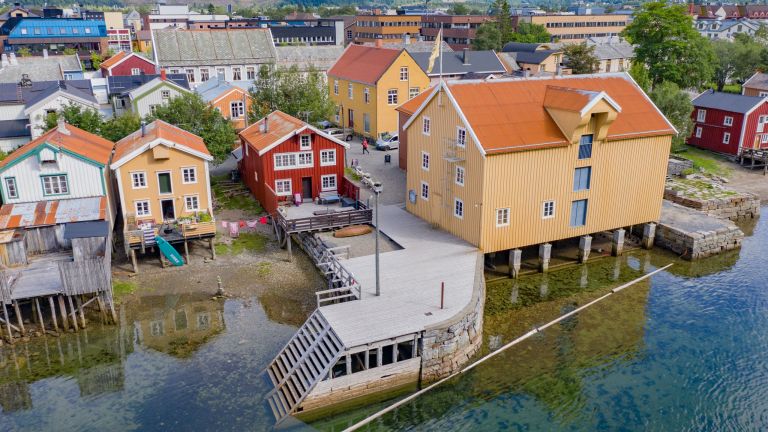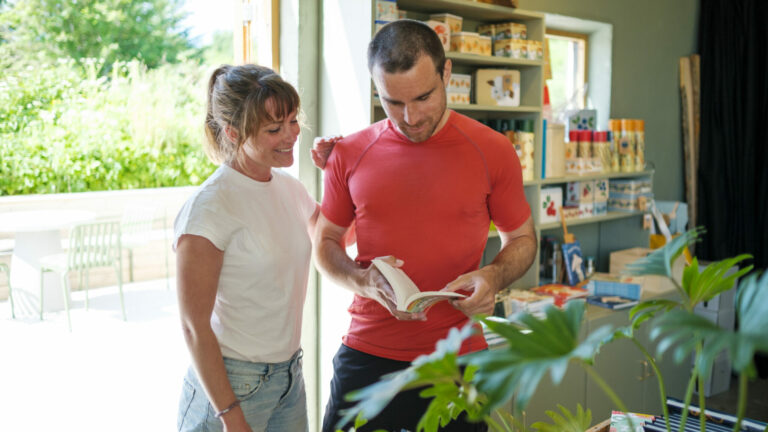In 1866, a veritable “Gold Rush fever” broke out in Mosjøen, an idyllic little town in the middle of Norway. A large sawmill (known as the “English sawmill”) was established, which turned Mosjøen into a meeting place for English timber barons, forestry workers from Odalen, Sami lumberjacks, Swedish mountain farmers who had come to town to barter, and tailors selling the latest styles from London and Paris
The English timber barons are long gone, but with its wharfs, warehouses, boathouses, mercantile buildings and houses—not to mention the mass of outbuildings, shacks and lean-tos that huddle amongst them—Sjøgata (Sea Street) is today a lively and picturesque part of Mosjøen town centre.
Sjøgata is a street in the center of Mosjøen. It runs parallel to the pedestrian street, along the river Vefsna. You can drive to Mosjøen by following the E6 south from Mo i Rana or north from Trofors, or travel to Mosjøen by train or plane.
Experience Sjøgata
Do as the locals: Get a coffee
The local people are proud of Sjøgata and are happy to show visitors around. Enjoy a stroll through the old 19th century district and admire the traditional timber building techniques and tools, decorative details and use of colour. Visit the little shops and craft workshops along the street and be sure to do as the locals of Vefsn do: Pop down to the café for a coffee — especially in the morning! Hear the buzz of talk and laughter over the tinkling of coffee cups as the world’s innumerable problems are “solved”. Café culture has a long history in Mosjøen, and Sjøgata in particular was known for its large number of coffee stalls and cafés.
Sjøgata in Mosjøen is a vibrant, living district with shops, cafés, accommodation, galleries, art exhibitions, preserved buildings and antique objects, a museum and much more. Many of the houses in the street belong to ordinary locals who are used to tourists walking through their gardens or peeping in their windows.
The Sjøgata quarter represented by Kulturverkstedet has been awarded the St. Olav’s Rose, the Norwegian Heritage Foundation’s mark of quality.
Stay in historic surroundings
The self-catering holiday apartments in Sjøgata are named after previous residents, and include “Gabrielsengården”, “Ola Oktoberbrygga” and “Aabakkengården”. Here you can enjoy your morning coffee at the kitchen window — just as they did in the 19th century. The houses are full of old-world charm and are decorated and furnished in the style of the period, but have all the modern conveniences to ensure guests a comfortable stay. They may all be furnished differently, but each house has good beds, plus a kitchen, living room and bathroom.
The venerable Fru Haugans Hotel is situated by the sea at the southern end of Sjøgata, and is surrounded by a large, beautiful garden. The hotel also has a visitors’ mooring. Dating back just over 200 years, Fru Haugans is the oldest hotel in Northern Norway and has been run by women for several generations. Now restored and modernised, the hotel has nevertheless retained much of its period style and intimate atmosphere.
Visit Helgeland Museum in Jakobsenbrygga
Helgeland Museum has its own wharf on Sjøgata and offers a range of exciting exhibitions all year round. The permanent exhibition on the history of the town shows the fascinating story of the colourful life in Sjøgata and in Mosjøen — the oldest town in Helgeland. The museum also puts on a changing range of themed exhibitions, concerts and other events.
Art and music festivals
Every year for a week in July, Sjøgata is taken over by the Galleria Kunstfestival art festival and the ByfestVeko music festival. Then the street is transformed into an 800-metre (half mile) long art gallery. Shops, boathouses, banks, hotels and restaurants all get involved and put on wonderful exhibitions of paintings, sculptures, sketches and photographs by artists of all kinds — famous and unknown, local and international. And there is music every where in the street. The festivals are always rounded off with an enormous town festival, when Sjøgata becomes one big festival site hosting some 5000 partygoers who gather to dance and enjoy the atmosphere late into the Saturday night. Music of all genres can be heard from the restaurants and cafés, with tunes to suit the most varied of tastes.
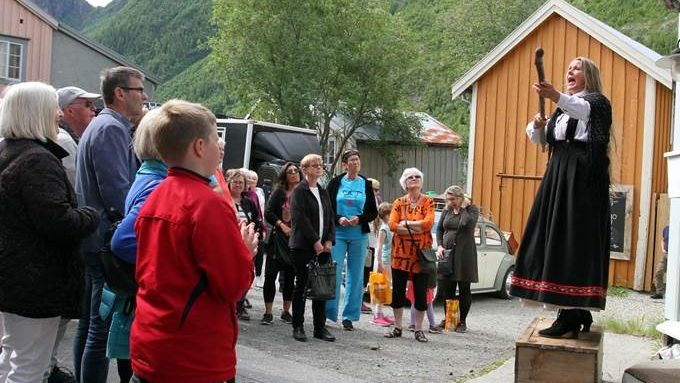 Photo: Galleria kunstfestival
Photo: Galleria kunstfestival
The history of Sjøgata
Decay and poverty
At the end of World War II, Sjøgata was left run-down and in decline, and many viewed it as a disgrace to the town. It was also a rather unpopular place to live. Many people associated this part of town with poverty, where the “old fellers”, who cycled into town to hang around on the street corner spitting tobacco, would often share a bottle of the hard stuff before cycling home again.
“Pull it all down”…
…was the verdict in the development plan proposed by Vefsn municipal council in 1970. An economic boom after the war had created great demand for parking spaces in Mosjøen town centre, and most people were in favour of demolishing the buildings in Sjøgata. Fortunately there were protests: Around a hundred people saw the value of preserving the street, and the local residents and other interested parties mobilised an increasing opposition to demolition. The European Architectural Heritage Year of 1975 generated a nationwide wave of publicity about what was happening in Mosjøen, and better funding was granted to preserve the Sjøgata area.
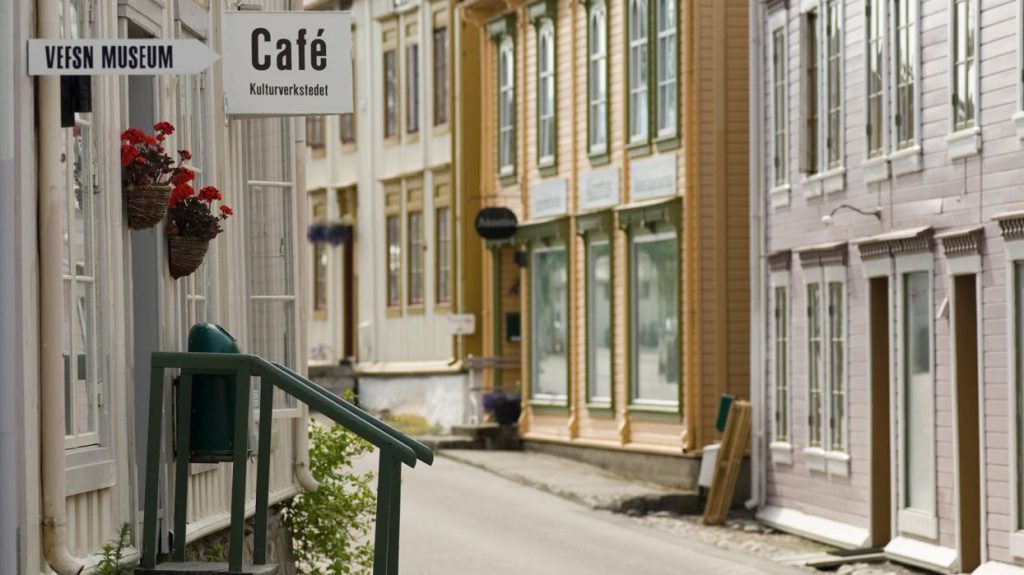 Terje Rakke, NordicLife / Visit Helgeland
Terje Rakke, NordicLife / Visit Helgeland
The assistance and support of architects, paint and colour specialists and experts from the Directorate for Cultural Heritage played an important role in the conservation project. The main objective was to make Sjøgata a living part of Mosjøen town centre. One of the projects involved turning the largest building in the area into a cultural and social centre and café, known today as Kulturverkstedet (the Culture Workshop).
Kulturverkstedet — hosting events in Sjøgata’s new auditorium
The building that houses the Kulturverkstedet was built in 1862 by merchant Jacob C. Jacobsen. In its time, the building was the largest and grandest mercantile building in Mosjøen. The work of preserving the wooden building began in 1981, and in 1984 the multi-purpose cultural centre emerged in all its glory. Today, the Kulturverkstedet is a well-known and much-loved centre for many cultural activities in Mosjøen. It is also a venue for meetings and conferences but, most of all, it is an important place for people to meet socially. The café serves traditional dishes from Vefsn, and in the gallery area (“Galleriet”), you can enjoy and purchase the works of professional artists — most of them from Northern Norway. The Galleriet is one of the largest galleries in this part of the country, displaying and selling art to tourists and locals, as well as local businesses. Galleri Stallen, just behind the cultural centre, houses the Alrunen antiquarian bookshop.
Some of the most popular events at Kulturverkstedet are the free lunchtime concerts held every Friday throughout the year in the Galleriet. Anyone who likes listening to good music can enjoy hearing local musicians perform—both professional and amateur—and socialise at the same time.
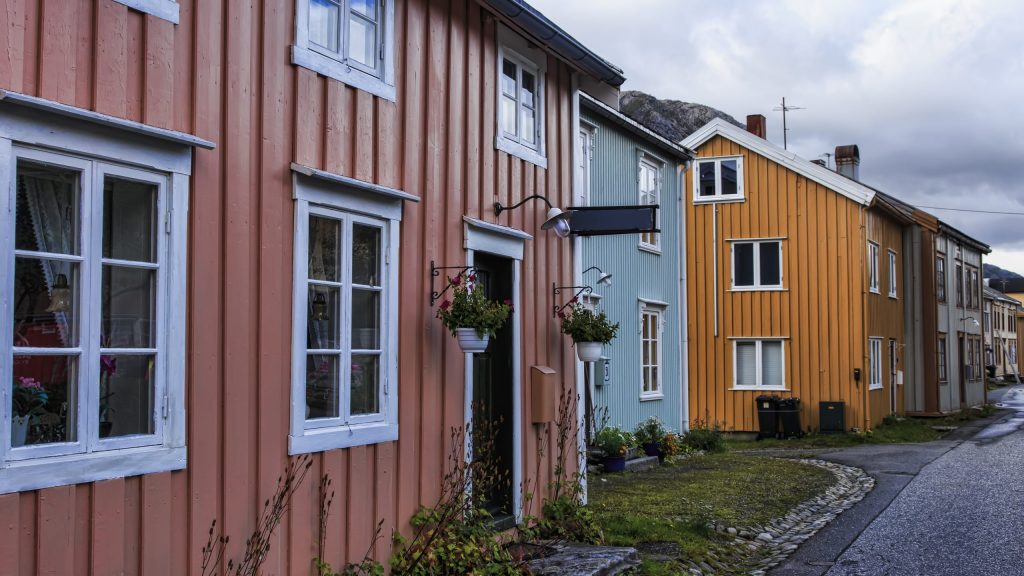 Cindy – Lou Dale
Cindy – Lou Dale
More things to do around Mosjøen

An exciting half-day rafting adventure at Trofors with RiverNorth
RiverNorth’s most popular excursion is the Half-Day Rafting Adventure. You get to challenge big waves – and see if you’re brave enough to dive from a cliff!
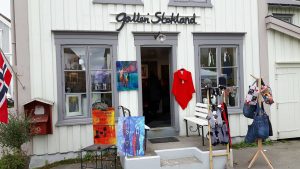
Galleri Stokland in Mosjøen
In a charming wooden house from 1852, on Sjøgata street in the historic heart of Mosjøen, you will find Galleri Stokland. On display are colourful artworks, knitwear, glass and ceramics by creative local craftsmen and artists.

Gilles Cafe & Restaurant in Mosjøen
This cozy cultural café in Mosjøen is located at the “beginning” of Sjøgata and offers good food, coffee, and both small and large concerts throughout the year.
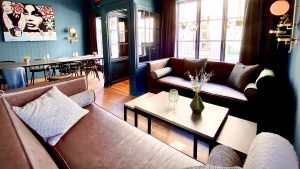
Blomsterbua Food & Wine in Mosjøen
On Sjøgata, the historic street in the heart of Mosjøen, you will find Blomsterbua Food & Wine. This cosy and beautifully decorated restaurant is suitable for every occasion.
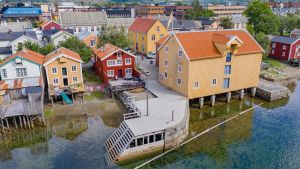
Jacobsenbrygga and the folk museum in Mosjøen
The Vefsn Museum has numerous exhibitions at several locations in and around the town of Mosjøen. These focus on everything from rural life and urban history, to weapons smuggling and the work of the Norwegian resistance during Nazi Germany’s World War II occupation. You can also join a guided tour of the historical street Sjøgata, which is lined with 19th-century houses.
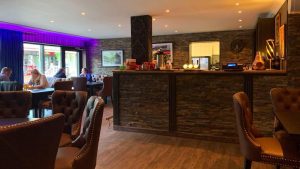
Restauranthuset Tipperary
Tipperary actually consists of three different establishments in a restaurant house that stands on a pleasant pedestrian street in the heart of Mosjøen.
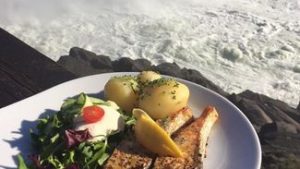
Laksforsen – Generations of tratidional food
Laksforsen is situated in Grane by highway E6, with a breathtaking panoramic view of a beautiful waterfall.
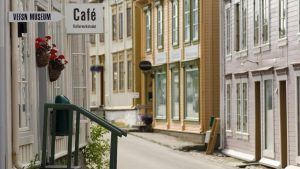
Kulturverkstedet Mosjøen – A cultural workshop
The cultural workshop in the old town, Sjøgata in Mosjøen, is a unique environment where past and present blend together.
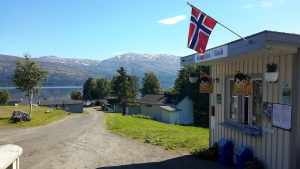
Aspnes Camping
Welcome to Helgeland and Aspnes Camping, beautifully situated by Fustvatnet lake, approximately 13 km north of Mosjøen.
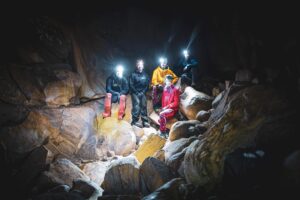
Øyfjellgrotta – A cave adventure near Mosjøen
Øyfjellgrotta is a 500 meter long limestone cave in a mountain that towers over the scenic town of Mosjøen. The experienced guides of Hi North invite you to book an unforgettable tour of the cave.
